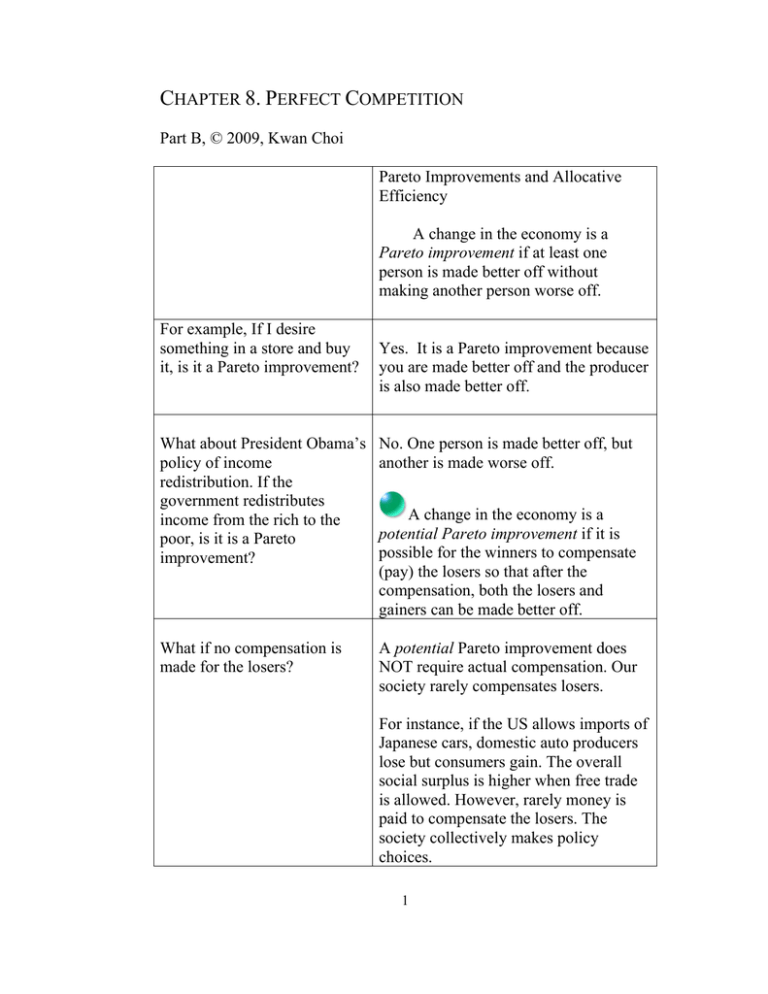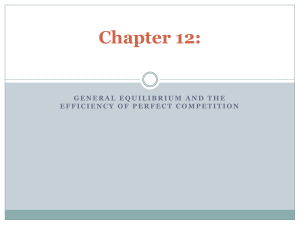C 8. P
advertisement

CHAPTER 8. PERFECT COMPETITION Part B, © 2009, Kwan Choi Pareto Improvements and Allocative Efficiency A change in the economy is a Pareto improvement if at least one person is made better off without making another person worse off. For example, If I desire something in a store and buy it, is it a Pareto improvement? What about President Obama’s policy of income redistribution. If the government redistributes income from the rich to the poor, is it is a Pareto improvement? What if no compensation is made for the losers? Yes. It is a Pareto improvement because you are made better off and the producer is also made better off. No. One person is made better off, but another is made worse off. A change in the economy is a potential Pareto improvement if it is possible for the winners to compensate (pay) the losers so that after the compensation, both the losers and gainers can be made better off. A potential Pareto improvement does NOT require actual compensation. Our society rarely compensates losers. For instance, if the US allows imports of Japanese cars, domestic auto producers lose but consumers gain. The overall social surplus is higher when free trade is allowed. However, rarely money is paid to compensate the losers. The society collectively makes policy choices. 1 A situation is Pareto efficient (allocatively efficient or economically efficient) if it is not possible to make one better off without making another worse off. If a situation is NOT Pareto efficient, what does it mean? Why are we studying Pareto efficiency? In that case, then there exists a way to reallocate resources to make one person better off without making someone else worse off. To demonstrate: Competitive Equilibrium is Pareto efficient. An equilibrium in competitive market requires efficiency in production, consumption and exchange. What is efficiency in production? PRODUCTION EFFICIENCY: At the intersection of demand and supply curves, each firm has already chosen an optimal combination of inputs as well as output to maximize its profit. Therefore, all firms have maximized their profits. Can you guess what properties consumption efficiency would require? Let me see. Right. CONSUMPTION EFFICIENCY: At the market equilibrium, each and every consumer has already chosen the 2 consumption bundle that maximize his/her utility. Consider a market equilibrium (p,Q). What then is exchange efficiency? EXCHANGE EFFICIENCY: To the left of Q, marginal benefit (or willingness to pay) exceeds marginal cost to producers. To the right of Q, marginal benefit falls short of marginal cost. At Q, willingness to pay = marginal cost. Accordingly, any deviation from Q that makes someone better off will necessarily make someone else worse off. So, a market equilibrium is Pareto efficient. Yes. But such a Pareto efficient equilibrium may not be sustainable. Sustainability In the SR, it is possible for the market to persuade firms to produce outputs even when their profits are negative. What do you mean by a market equilibrium that is not sustainable? Even if price falls below average cost, it pays them to stay in business, rather than to shut down. Even though a firm is losing money, it is minimizing losses, and shutting down is more costly. Right. Profit versus Loss Thus, in order to sustain a market equilibrium, profits of firms must be at least nonnegative. Profit = π = pq − c(q) = q( p − AC ). 3 If p > AC, then profit If p < AC, then loss In order to sustain a market equilibrium, p ≥ AC. If p > AC, such a market equilibrium is not sustainable either. Why not? If the representative firm is making positive profits, more firms will enter the market, and output will continue to rise. Right. Then profits of the representative producer must not be positive. p ≤ AC. For a long run equilibrium of the market, then price must not be below AC, and price must not be greater than AC. Then the only solution is: Absolutely! p = AC. Market Supply Curve = a horizontal summation of individual supply curves. 4 Who is footing the bill for the health care? EFFECT OF A SPECIFIC TAX The government is expected to force businesses to pay for the universal health care costs. Does the tax affect workers in general? It will make it even more difficult for the unemployed workers to find jobs in the labor market. Firms have to pay tax initially, and labor cost rises. Firms will be hiring fewer workers, and hence unemployment rate will rise. Then consumers will remain unaffected, right? No. In the SR, a specific tax t is shared by producers and consumers, depending on the slopes of demand and supply curves. In the left panel, the vertical distance between S and S+t , is the 5 specific tax imposed on the producers. However, because the market demand curve is negatively sloped, consumers end up paying some portion (p' – p). Absolutely. Is the split of tax burden different in the LR? However, the LR supply curve is horizontal. All specific taxes will be paid by consumers. The above answer was based on the assumption of NO IMPORTS. What if imports are available? In the SR, if imports are available, consumers just switch to foreign imports or outsourcing. This will further increase domestic unemployment. The health care bill encourages outsourcing. Suppose a US industry was competitive before the tax, which means the domestic unit cost = foreign unit cost. What will happen to the domestic industries in the LR? Any increase in tax will make the industry uncompetitive in the world market. The industry might fold. If world price p* = AC + tax, then it will survive. If p* > AC + tax, the US will export the product (agricultural products). If p* < AC + tax, the US will begin to import the product. 6 7







